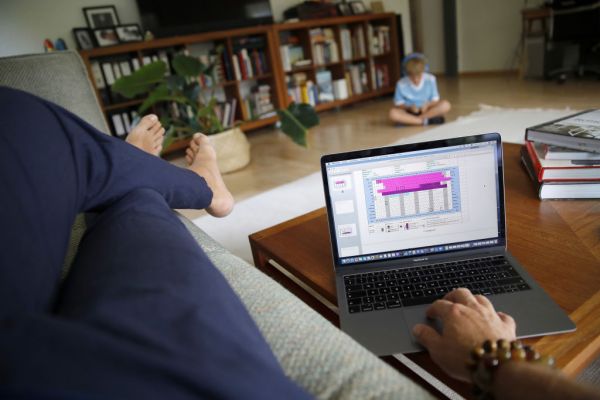10 years ago, Apple finally convinced us to lock our phones
Touch ID was a blessing for lazy teens like me who couldn’t be bothered to set an unlocking PIN. | Photo by Lintao Zhang / Getty ImagesEvery phone you pick up today has a fingerprint scanner, a face scanner,...
/cdn.vox-cdn.com/uploads/chorus_asset/file/24913092/181281518.jpg)
Every phone you pick up today has a fingerprint scanner, a face scanner, an option for PINs with four, six, or more digits, and often all of them at once. Phones prompt you to set up a scan and a passcode the first time you turn them on, and you’d be hard-pressed to find anyone who doesn’t have some form of security set up.
But go back just 10 years, and the story was very different. Back when our phones were still used almost entirely as phones and not teeny personal computers, most of the “locking” features on mobile devices were designed more to prevent you from butt-dialing anyone than to protect your sensitive information.
It wasn’t until the iPhone 5S came along — 10 years ago this month — that everything changed.
Photo by Justin Sullivan / Getty Images
Smartphones had long offered passcodes for protection, but actually using them felt like a nuisance. I had to tap my four-digit code into whatever model I was using every time I wanted to check my phone, and considering I was a teenager in the early 2010s, I checked my phone a lot. One study in 2013 found that the average person unlocked their phone 110 times each day, and I certainly surpassed that on numerous occasions.
And so, most people didn’t set up any sort of code. According to a Consumer Reports study published the same year, around 53 percent of smartphone users in the US didn’t set a passcode to protect their phone, either because they didn’t believe they had cause to or because they couldn’t be bothered to keep unlocking it. Which is understandable, really, when you remember that phones typically carried far less sensitive data back then. They had your contact numbers, blurry photographs, and (eventually), social media apps like Facebook.
In 2013, Apple set out to change that. The iPhone 5S was the first iPhone model to feature Touch ID, a fingerprint recognition feature that allowed users to swiftly unlock the device with a single tap of the home button. From the placement of the fingerprint reader to the unlocking motion itself, Touch ID felt effortless. It became a subconscious action you didn’t notice you were doing. That finger tap wasn’t just easier to use compared to the previous swipe-to-unlock gesture — it was actually a better and faster login experience overall.
You only need to look at the wider phone smartphone market in the months following the iPhone 5S’s release in September 2013 to know how influential it was. When the Samsung Galaxy S5 launched in April 2014, it was the first Galaxy phone to feature a fingerprint scanner. The Sony Xperia Z3 — another popular handset from 2014 — shortly followed when it launched in September of the same year, and then pretty much everyone was doing it.
Photo by Stephen Lam / Getty Images
Touch ID didn’t just bring biometric device locking into the mainstream: it was also a turning point for our phones storing our most personal data. At the time, Touch ID allowed users to authorize App Store and iTunes purchases without inputting their device passwords. When the iPhone 6 and 6 Plus launched in 2014, Apple added the ability to use Touch ID to authenticate purchases in the real world via Apple Pay.
In the years following, mobile apps for things like e-commerce and online banking have adopted biometrics not just for security but also for convenience over unique, complex passwords. And we likely have Apple to thank for making that possible — Touch ID marked the turning point when Apple started to introduce iPhone features that required more sensitive data to be stored on the device, like personal health information and credit cards for making purchases. Now, we now use our phones for everything. They unlock our cars, make contactless payments, and facilitate all manner of tasks that require us to upload and / or store sensitive personal information. It’s little wonder that Apple still has a continued focus on security and user privacy given the success of Touch ID.
While the iPhone 5S certainly popularized the fingerprint scanner, it wasn’t actually the first phone to launch with such a feature. Most sources point to the Pantech GI100, which launched in 2004 with a scanner mounted in the middle of the D-pad. Android also beat Apple to the punch with the 2011 Motorola Atrix 4G, which featured a swipe-based scanner on the top of the device. But early implementations were awkwardly placed and hard to use — which may be why they rarely showed up until Apple’s offering broke fingerprint scanners into the mainstream.
Image: Arstayl
Apple’s implementation worked so well, in fact, that a global study from 2021 found that almost 99 percent of participants locked their mobile devices, with fingerprint scanners tying with PINs and passwords as the most popular security methods.
Touch ID’s impact on smartphone design and security can still be felt across almost every major smartphone release in the 10 years since it was first introduced. Regardless of where brands first placed early fingerprint scanners, almost every rival phone maker eventually settled on sticking it at the bottom of the front screen within easy reach of your thumb — exactly where it was on the iPhone 5S.
It’s hard to say if having such a feature also helped to popularize apps that need additional security authorization, but it certainly encouraged me to manage stuff like banking and private messaging from my phone rather than a laptop. And while software-based solutions like end-to-end encryption exist to help prevent bad actors from remotely accessing sensitive data stored on your smartphone, the main frontline security measure is still locking the device, preventing potential thieves or other ne’er-do-wells from simply taking the phone and rifling through everything.
Looking back at this legacy, it’s rather amusing that iPhones are now one of the few big smartphones to have removed fingerprint-based identification. (With the lone exception of the iPhone SE.) Face ID — which allows users to unlock their device using facial recognition — launched with the iPhone X in 2017 as the successor to Touch ID and has since become the flagship biometric identification method for the company.
Image: Elijah Nouvelage / AFP via Getty Images
Google once again beat Apple to the punch by introducing facial recognition unlocking back in 2011 with Android 4.0, but it didn’t perform well due to its reliance on regular cameras and lighting, and market-wide adoption was slow. Apple found success by following its usual blueprint of convenience — making the feature simple and user-friendly. At the right angle, Face ID doesn’t require any input from the device user at all, making it faster, more efficient, and overall less effort than scanning a fingerprint.
There have been whispers that fingerprint scanning may be reintroduced to iPhone models following rumors that Apple was testing solutions for in-screen Touch ID. But at this point, it really doesn’t matter what type of scanners the iPhone offers: Apple has already succeeded in getting us to lock our phones.

 Lynk
Lynk 































